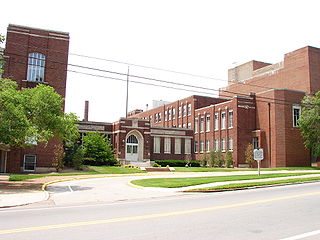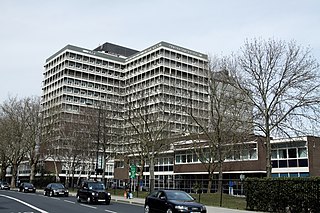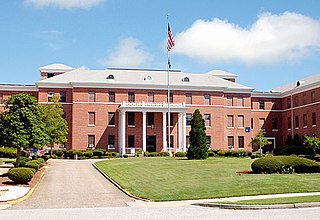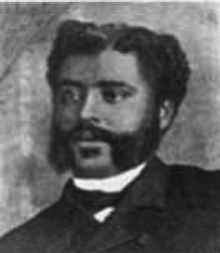
Montgomery is the capital city of the U.S. state of Alabama and the county seat of Montgomery County. Named for Continental Army Major General Richard Montgomery, it stands beside the Alabama River, on the coastal Plain of the Gulf of Mexico. The population was 200,603 at the 2020 census. It is now the third most populous city in the state, after Huntsville and Birmingham, and is the 128th most populous in the United States. The Montgomery Metropolitan Statistical Area's population in 2022 was 385,460; it is the fourth largest in the state and 142nd among United States metropolitan areas.

Meharry Medical College is a private historically black medical school affiliated with the United Methodist Church and located in Nashville, Tennessee. Founded in 1876 as the Medical Department of Central Tennessee College, it was the first medical school for African Americans in the South. While the majority of African Americans lived in the South, they were excluded from many public and private racially segregated institutions of higher education, particularly after the end of Reconstruction.

St James's University Hospital is a tertiary hospital in Leeds, West Yorkshire, England and is popularly known as Jimmy's. It is the 8th largest hospital by beds in the United Kingdom, popularised for its television coverage from 1987 to 1996. It is managed by the Leeds Teaching Hospitals NHS Trust.

Halle Tanner Dillon Johnson was an American physician and the first woman to be licensed as a physician in the U.S. state of Alabama.

James Marion Sims was an American physician in the field of surgery. His most famous work was the development of a surgical technique for the repair of vesicovaginal fistula, a severe complication of obstructed childbirth. He is also remembered for inventing the Sims speculum, Sims sigmoid catheter, and the Sims position. Against significant opposition, he established, in New York, the first hospital specifically for women. He was forced out of the hospital he founded because he insisted on treating cancer patients; he played a small role in the creation of the nation's first cancer hospital, which opened after his death.

Charing Cross Hospital is district general hospital and teaching hospital located in Hammersmith, London, United Kingdom. The present hospital was opened in 1973, although it was originally established in 1818, approximately five miles east, in central London.

The Royal Infirmary of Edinburgh (RIE) was established in 1729, and is the oldest voluntary hospital in Scotland. The new buildings of 1879 were claimed to be the largest voluntary hospital in the United Kingdom, and later on, the Empire. The hospital moved to a new 900 bed site in 2003 in Little France. It is the site of clinical medicine teaching as well as a teaching hospital for the University of Edinburgh Medical School. In 1960 the first successful kidney transplant performed in the UK was at this hospital. In 1964 the world's first coronary care unit was established at the hospital. It is the only site for liver, pancreas, and pancreatic islet cell transplantation in Scotland, and one of the country's two sites for kidney transplantation. In 2012, the Emergency Department had 113,000 patient attendances, the highest number in Scotland. It is managed by NHS Lothian.

The University of Alabama at Birmingham Marnix E. Heersink School of Medicine is the medical school of the University of Alabama at Birmingham (UAB) located in Birmingham, Alabama, United States with branch campuses in Huntsville, Montgomery, and Tuscaloosa. Residency programs are also located in Selma, Huntsville, and Montgomery. It is part of the University of Alabama at Birmingham (UAB) and the UAB Health System, one of the largest academic medical centers in the United States.

The Huntsville Hospital Health System is a public, not-for-profit hospital organization consisting of several sites and buildings, originating in the downtown area of Huntsville, Alabama. The Huntsville Hospital Health System has evolved and now either owns or works with several other hospitals in Alabama. It has around 13,000 employees, 2,000 nurses and 650 physicians.
The Egmore Eye Hospital, officially the Regional Institute of Ophthalmology and Government Ophthalmic Hospital, is a public eye hospital in Chennai, India. Considered the oldest eye hospital in Asia, the institute was established in 1819 and is the second oldest hospital of its kind, next only to the Moorfields Eye Hospital in the United Kingdom.
The University of Edinburgh Medical School is the medical school of the University of Edinburgh in Scotland and the United Kingdom and part of the College of Medicine and Veterinary Medicine. It was established in 1726, during the Scottish Enlightenment, making it the oldest medical school in the United Kingdom and the oldest medical school in the English-speaking world.

Kilby Correctional Facility is an Alabama Department of Corrections (ADOC) prison for the state of Alabama, located in Mt. Meigs, an unincorporated area in Montgomery County, Alabama, with a capacity to house over 1,400 inmates. A section of the city of Montgomery covers a portion of the prison facility.

The Tuskegee Veterans Administration Medical Center began in 1923 as an old soldiers' home in Tuskegee, Alabama. It was originally called the Tuskegee Home, part of the National Home for Disabled Volunteer Soldiers system.

Miles Phifer and Robert Crosky were lynched in Montgomery, Alabama, for allegedly assaulting a white woman.

Burgess E. Scruggs was an American physician, alderman, and civic leader in Huntsville, Alabama. He was one of Alabama's first African American doctors, and the first in Huntsville. He served four terms on Huntsville's city council.

Will or Willie Temple was an African American man who was lynched by a white mob on September 30, 1919, in Montgomery, Alabama.

Cornelius Nathaniel Dorsette was an American physician who is often called the first African American doctor licensed in the state of Alabama. He was also the founder of Hale Infirmary, the first hospital in Montgomery for African American patients, staffed by African American doctors and nurses.

Arthur McKinnon Brown, also known as Arthur McKimmon Brown, was an American physician. In the city of Birmingham, Alabama, Brown was one of the earliest African American physicians, and the first African American surgeon in the United States Army. He was an influential in the creation of the Children's Home Hospital of Birmingham. For many years it was the only hospital in the city where Black doctors could practice.
















